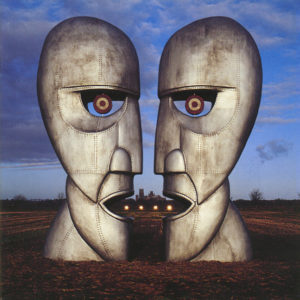Columbia 64200
Producers: Bob Ezrin and David Gilmour
Track listing: Cluster One / What Do You Want From Me / Poles Apart / Marooned / A Great Day for Freedom / Wearing the Inside Out / Take It Back / Coming Back to Life / Keep Talking / Lost for Words / High Hopes

April 23, 1994
4 weeks
To record their first studio album since 1987, Pink Floyd regrouped at Astoria, David Gilmour’s floating studio on the River Thames. A lot had transpired since the chart-topping triumph of The Wall in 1979. In 1983, Pink Floyd recorded one more album with Roger Waters before the bassist/vocalist left the band. That album, appropriately dubbed The Final Cut, reached number six. Four years later, the Floyd fared better when A Momentary Lapse of Reason, their first album recorded as a trio, reached number three.
The Division Bell was spawned from two weeks of jamming and then close to a year of work, on and off, in the studio. “We started off with the band going into a rehearsal studio for a few weeks, where they basically reconnected with each other and jammed and played together as a band,” says co-producer Bob Ezrin. “We recorded the whole thing and in that there were a lot of Pink Floyd musical moments, so we extracted those from the tape of the jam session and began there with those germs to construct the material for the album.”
With Floyd’s Gilmour, Nick Mason, and Rick Wright seasoned professionals, the sessions were workmanlike. “The band hadn’t changed that much over the years,” Ezrin says. “Sometimes they were a little frivolous, but mostly they were quite serious. They have maintained their sense of humor and sense of humanity, and everyone has stayed relatively unpretentious.”
Ezrin, who worked on The Wall and A Momentary Lapse of Reason, wasn’t the only person to reunite with Pink Floyd for The Division Bell. Michael Kamen, who arranged the strings on The Wall, also returned, as did saxophonist Dick Parry, who had last worked with the band on “Money” from The Dark Side of the Moon. “It was a really sweet and wonderful type of reunion,” says Ezrin. “Dick was a little nervous and self-deprecating. He was saying that he wasn’t sure that he would be able to cut it, but as soon as he started to blow his horn, we realized he was the right guy, because he had the sort of vibe we were looking for.”
While most of the songs were an outgrowth of the initial jam sessions, the album’s closing track, “High Hopes,” came later. “Dave literally went in one week on his own and had inspiration and came back and presented it in almost finished form to the band,” says Ezrin. “The demo sounds very much like what is an the record. We just added a few things to it in terms of arrangement.”
With the release of The Division Bell on the horizon, Pink Floyd announced that they would again launch a massive North American tour. Even before the album’s release, the band had sold more than a million tickets to the first 22 dates on the tour, which included a stop at Yankee Stadium in New York.
With the excitement of the tour in full swing, The Division Bell became the first Pink Floyd album to debut in the pole position, and the band’s fourth career chart-topper.
THE TOP FIVE
Week of April 23, 1994
1. The Division Bell, Pink Floyd
2. Above the Rim, Soundtrack
3. The Sign, Ace of Base
4. Longing in Their Hearts, Bonnie Raitt
5. August & Everything After, Counting Crows
